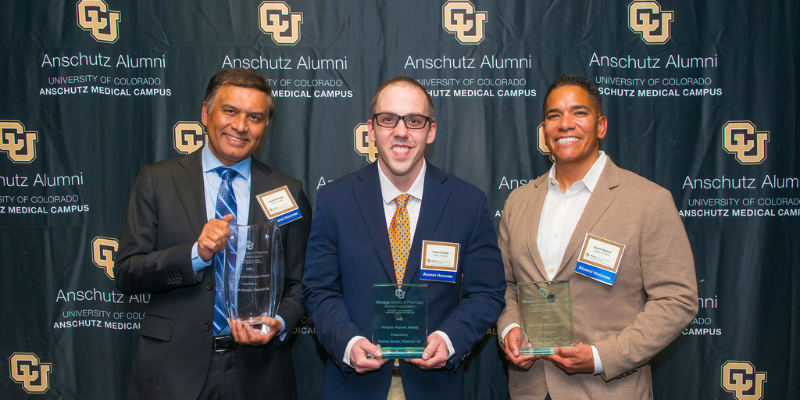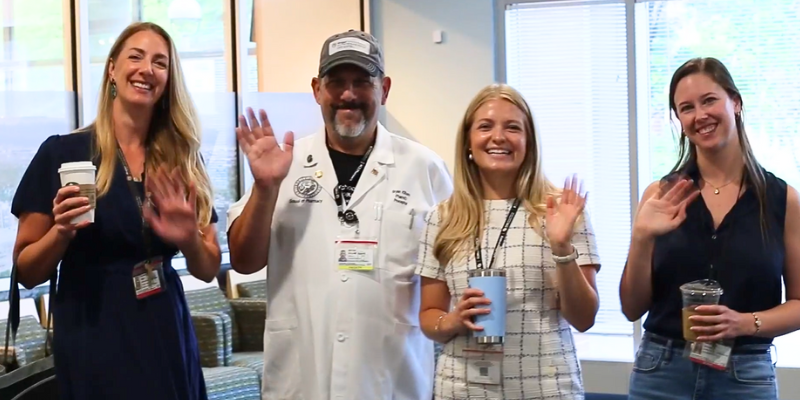This year marks the 100th anniversary of Rho Chi, the academic honor society for pharmacy. In special acknowledgment of the occasion, this month’s alumni spotlight focuses on a former president of the CU Pharmacy Alpha Theta chapter of Rho Chi, Laura Tyndall. Laura marks her 40-year anniversary as a 1982 graduate of CU Skaggs School of Pharmacy and Pharmaceutical Sciences. She looks back on the last 40 years and the opportunities that have come her way in that time. Continuing with the feature on alumni milestones, Laura provides a retrospective on the changes she’s experienced in the pharmacy profession and her role in influencing those changes. A pivotal moment in particular shaped her career focus and would forever change pharmacy to improve measures for maintaining prescription records and documenting patient care using modern technology. The high-profile case served as the catalyst for the need to track the ordering, dispensing, and administration of medication to patients.
In 2006, Charles Cullen was sentenced to eleven consecutive life sentences for administering overdoses to patients in hospitals during the prior decade. The case revealed the need for more oversight in healthcare with respect to the dispensing and administration of medication. In order to accomplish this, the healthcare community incorporated the use of information technology to better inform pharmacists, physicians, and nurses on the medication history of patients and to avoid the unauthorized use of medication. As the Network Pharmacy Director, Laura was a team leader in the implementation and training needed for a multi-hospital health network in Pennsylvania, bringing healthcare workers up to speed in using new technologies in pharmacy automation (robotics and dispensing cabinets), barcode medication administration and electronic physician ordering. Her passion for medication safety led to a dual career in hospital pharmacy and then product management for an electronic health record software vendor. She was an early advocate for the new age of Health Informatics.


What are you currently doing as a pharmacy professional and how did you progress to where you are today?
Currently, I am semi-retired from hospital pharmacy and software vendor management. I’m still licensed in Colorado and Pennsylvania and looking for the right part-time opportunity. In 2021, I joined the State Emergency Registry of Volunteers in Pennsylvania (SERVPA) and assisted with the pharmacist staffing of volunteers at Covid vaccine clinics sponsored by the Allentown Health Bureau. We administered 50,000 vaccine doses over 11 months.

What is different about the person you are today compared to the person you were while in school?
I’m more inclined today to really stop and smell the roses. Also, I no longer want to be called a perfectionist. Someone once defined perfectionist as “someone who takes great pains. . .and gives them (to others).” I did not want the second part of the statement associated with me. I’ve learned where I can compromise and yet maintain strong boundaries in the name of patient safety.

What has been a defining moment for you as a seasoned professional?
.png?width=292&name=Headshots%20300%20x%20400%20(2).png) Laura Tyndall, PharmD (RPh '82) |
An incredible defining moment was when a nurse confessed to murdering 40 people with drugs in hospitals in the states of New Jersey and Pennsylvania over about 16 years. At one of our system hospitals, seven of our patients had been his targets. Much of my career was defined by the implementation of safety initiatives to never let that type of tragedy happen again. The theme of “Medications, Murder and Modernization of Healthcare Safety” is a big theme of my career. I jumped at the opportunity to pilot and provide training to healthcare professionals in using health information technology and electronic medical record systems. I remember the resistance in using the new tools because it added to an already heavy workload for healthcare professionals. Once staff were able to see the value and safety it provided in helping them perform their work more efficiently (and better assist patients), it became a game changer for them. I recall one individual who was convinced that learning the new system was a complete waste of time. After I was able to persuade them to at least give the system a chance, they had an “ah-hah” moment on the improved safety which kept them from accidentally making an error, and that person became one of our biggest advocates for using health technology tools.

What inspired you to attend the CU Pharmacy program and what was your experience while in the program?
My mother succumbed to cancer while I was a teenager and I had a front row seat to the roles of healthcare givers (doctors, oncologists, nurses, pharmacists, etc.) and I identified with the pharmacist as something I would want to do and pay it forward by helping others as we had been helped. In the 1970s, there was only one pharmacy school in the state of Colorado. While the choice was limited, I loved Boulder and the Pharmacy School was located on the University of Colorado main campus at that time. Back then we started with about 75-80 students and the final class size was approximately 60 graduates. We had a chance to really know our classmates and teachers as we moved like a herd through three years of focused study. Two years of pre-pharmacy was general at most other colleges. My experience was very positive and I learned a tremendous amount of knowledge and skill.
After working a few years, I decided to pursue a two-year add-on PharmD graduate program at a school in Pennsylvania because the PharmD was not offered at CU at the time. I completed the PharmD there and followed that with a residency through the American Society of Health-System Pharmacists (ASHP). As “life” happened, I ended up staying in Pennsylvania where I met my spouse and raised a family.

What is your proudest moment and your favorite thing about working in the pharmacy profession?
My proudest accomplishment was the installation of more than 300 pieces of pharmacy automation, overcoming the resistance to change by hundreds of staff, and having moments where personnel would later stop and thank me for helping them to not make a mistake and harm a patient. I’m also proud at seeing how, a generation later, the “new” technology is now so commonplace in being a part of routine care that no healthcare professional could do without it.

What sage advice would you pass on to current and future students that was helpful for you in preparing for the job market?
My message to CU Pharmacy graduates is that many opportunities for your future career may not yet be invented, so keep an open mind. You just never know where the road may take you. Many aspects of my career were not “traditional”. Also, it is okay to let an opportunity go by if you are not quite ready or the timing is wrong. Something else “right” will come along. However, try to keep a balance between not being ready and being overly qualified before making a change.
Rho Chi alumni of CU Pharmacy’s Alpha Theta chapter are invited to participate via live stream in the induction ceremony for 2022 members. Join the celebration Friday, April 15 at 4 p.m. (Mountain Time).
.png)



.png)